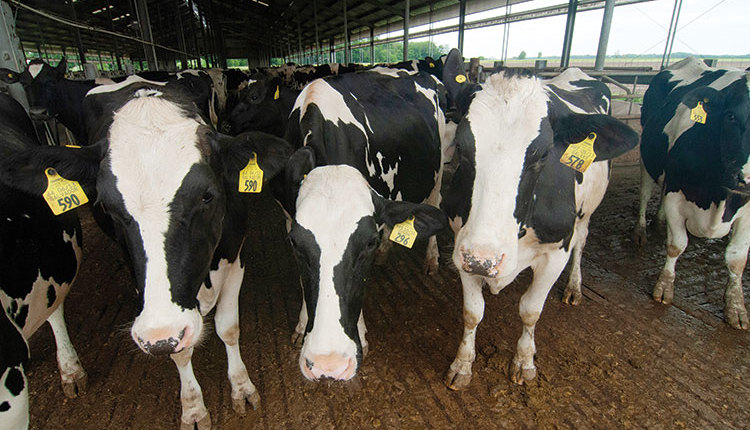The author is professor of animal sciences at Kansas State University, Manhattan.
One of your greatest assets should be your heifer population. Raising quality heifers starts with proper sire selection, good dry cow and late-gestation heifer care, proper handling and feeding of newborn heifers, careful attention to heifer growth, and breeding future replacements. All of these decisions are critical to producing the next generation of replacements. Let's look at some of the newer A.I. breeding options that are available.
Heat detection only option. In order to determine standing events, researchers used the HeatWatch electronic estrus-detection system marketed by Cow Chips LLC, Manalapan, N.J. That system employs a rump-mounted pressure sensitive device that detects the weight or pressure from a mounting animal. When in heat, Jerseys stood more times than Holsteins, but duration of heat and resulting conception rates were not different between Holstein and Jersey heifers (Table 1). Clearly, conception rates achieved were excellent.

Heat detection plus PGF. A number of good, large-scale studies are available that validate the success of using a simple prostaglandin F2a (PGF)-based system coupled with good visual observation before A.I. breeding of replacements. One such study comprising nearly 3,000 heifers in 45 herds is summarized in Table 2.

Ovaries of heifers were palpated before injecting PGF, and 8.3 percent were classified as anovulatory and not injected. Remaining heifers then were injected and watched for estrus and inseminated. If no heat was detected, 11 days later the remaining noninseminated heifers were reinjected with PGF. A greater proportion of heifers were detected in heat after two than after one injection; however, conception rates were slightly greater for those heifers injected only once. Heifers not detected in heat after both injections received a fixed-time A.I. at 80 hours after PGF, to which 40.6 percent conceived.
Timed A.I. options. Previous use of fixed-time insemination in dairy heifers has produced quite variable responses. A summary of such attempts was made by Bill Thatcher at the recent Dairy Cattle Reproduction Council meeting.
He summarized seven reports in which heifers were exposed to Ovsynch (injection of GnRH seven days before and 48 hours after PGF, with fixed-time A.I. given 12 to 18 hours after GnRH) or Cosynch (injection of GnRH 7 days before and 48 to 72 hours after PGF at the same time as the one fixed-time A.I.) type protocols with or without a seven-day progesterone-releasing intravaginal insert (CIDR).
The average pregnancy rate was 40.6 percent in 963 heifers - not different from what is reported in Table 2 with the basic PGF system and A.I. breeding at 80 hours after the second PGF injection.
New five-day CIDR option. A five-day CIDR protocol in Florida studies has emerged as a potentially good timed A.I. system for heifers. The program consists of a GnRH injection at CIDR insertion (Day 0). The CIDR is removed in five days when PGF is administered (Day 5) and one fixed-time A.I. occurs at 72 hours or three days later (Day 8).
For example, if one starts the protocol on Wednesday a.m., the CIDR can be removed and PGF injected the following Monday a.m., and insemination on Thursday a.m. Results show that this program is a viable alternative to other systems (Table 3). As expected, results varied between herds as they do with any other A.I. protocol.

Further work by the authors using sexed-sorted semen showed that pregnancy rates were about 80 percent of that achieved with conventional semen. This loss in fertility is consistent with other studies in which sexed-sorted semen was compared with conventional semen in cattle that were inseminated after detected heats.
They also should be the most fertile dairy females on your farm. Selecting a breeding protocol that fits your management style and labor availability is an important consideration in your choice.
When labor is a limiting factor to carry out a good twice daily heat detection program, timed A.I. is an alternative. The Florida studies have demonstrated that open heifers detected by ultrasound at 30 to 32 days after first A.I. breeding can be reinserted into a five-day CIDR program with success equal to those synchronized at first A.I. breeding.

Let's keep as many as those good home-grown heifer resources in your breeding herd as possible.
Click here to return to the Reproduction E-Sources
100510_354
One of your greatest assets should be your heifer population. Raising quality heifers starts with proper sire selection, good dry cow and late-gestation heifer care, proper handling and feeding of newborn heifers, careful attention to heifer growth, and breeding future replacements. All of these decisions are critical to producing the next generation of replacements. Let's look at some of the newer A.I. breeding options that are available.
Heat detection only option. In order to determine standing events, researchers used the HeatWatch electronic estrus-detection system marketed by Cow Chips LLC, Manalapan, N.J. That system employs a rump-mounted pressure sensitive device that detects the weight or pressure from a mounting animal. When in heat, Jerseys stood more times than Holsteins, but duration of heat and resulting conception rates were not different between Holstein and Jersey heifers (Table 1). Clearly, conception rates achieved were excellent.

Heat detection plus PGF. A number of good, large-scale studies are available that validate the success of using a simple prostaglandin F2a (PGF)-based system coupled with good visual observation before A.I. breeding of replacements. One such study comprising nearly 3,000 heifers in 45 herds is summarized in Table 2.

Ovaries of heifers were palpated before injecting PGF, and 8.3 percent were classified as anovulatory and not injected. Remaining heifers then were injected and watched for estrus and inseminated. If no heat was detected, 11 days later the remaining noninseminated heifers were reinjected with PGF. A greater proportion of heifers were detected in heat after two than after one injection; however, conception rates were slightly greater for those heifers injected only once. Heifers not detected in heat after both injections received a fixed-time A.I. at 80 hours after PGF, to which 40.6 percent conceived.
Timed A.I. options. Previous use of fixed-time insemination in dairy heifers has produced quite variable responses. A summary of such attempts was made by Bill Thatcher at the recent Dairy Cattle Reproduction Council meeting.
He summarized seven reports in which heifers were exposed to Ovsynch (injection of GnRH seven days before and 48 hours after PGF, with fixed-time A.I. given 12 to 18 hours after GnRH) or Cosynch (injection of GnRH 7 days before and 48 to 72 hours after PGF at the same time as the one fixed-time A.I.) type protocols with or without a seven-day progesterone-releasing intravaginal insert (CIDR).
The average pregnancy rate was 40.6 percent in 963 heifers - not different from what is reported in Table 2 with the basic PGF system and A.I. breeding at 80 hours after the second PGF injection.
New five-day CIDR option. A five-day CIDR protocol in Florida studies has emerged as a potentially good timed A.I. system for heifers. The program consists of a GnRH injection at CIDR insertion (Day 0). The CIDR is removed in five days when PGF is administered (Day 5) and one fixed-time A.I. occurs at 72 hours or three days later (Day 8).
For example, if one starts the protocol on Wednesday a.m., the CIDR can be removed and PGF injected the following Monday a.m., and insemination on Thursday a.m. Results show that this program is a viable alternative to other systems (Table 3). As expected, results varied between herds as they do with any other A.I. protocol.

Further work by the authors using sexed-sorted semen showed that pregnancy rates were about 80 percent of that achieved with conventional semen. This loss in fertility is consistent with other studies in which sexed-sorted semen was compared with conventional semen in cattle that were inseminated after detected heats.
They also should be the most fertile dairy females on your farm. Selecting a breeding protocol that fits your management style and labor availability is an important consideration in your choice.
When labor is a limiting factor to carry out a good twice daily heat detection program, timed A.I. is an alternative. The Florida studies have demonstrated that open heifers detected by ultrasound at 30 to 32 days after first A.I. breeding can be reinserted into a five-day CIDR program with success equal to those synchronized at first A.I. breeding.

Let's keep as many as those good home-grown heifer resources in your breeding herd as possible.
100510_354










